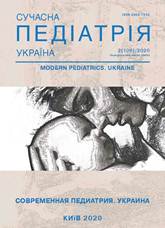Phonocardiography and patent ductus arteriosus in preterm infants
Keywords:
patent ductus arteriosus, hemodynamically significant patent ductus arteriosus, phonocardiogram, preterm infantsAbstract
Purpose. To investigate the possibility of heart tones analysis for diagnostic screening of ductus arteriosus status in preterm infants based on the analysis of computer phonocardiogram parameters for different hemodynamic significance of patent ductus arteriosus.
Materials and methods. 45 preterm infants undergoing treatment in the intensive care unit were examined. phonocardiogram (PCG) with an electronic stethoscope and echocardiography were performed. 40 (89%) newborns had ultrasound signs of hemodynamically insignificant patent ductus arteriosus (PDA) (PDA with minor shunting), 5 infants (11%) had signs of hemodynamically significant patent ductus arteriosus (HSPDA). A comparison of the 5 key PCG computer analysis indicators (characteristics of the tones and the interval between the first and second tones) was performed.
Results. Significant differences of particular indicators of PCG computer analysis of preterm infants with different shunting intensity of PDA were established. These indicators characterize the intervals between the first and the second tones in case if comparing minor and moderate shunting, and additional indicators characterize the ratio between the first and the second tones if comparing moderate and significant shunting. The indicators can be used to develop a screening diagnostics algorithm for the hemodynamic significance of PDA by means of PCG computer analysis.
Conclusions. Statistically significant differences in PCG analysis were found in preterm infants with varying degrees of hemodynamic significance of the patent ductus arteriosus. The results obtained can be used as a diagnostic screening in preterm infants with PDA.
The research was carried out in accordance with the principles of the Helsinki Declaration. The study protocol was approved by the Local Ethics Committee of an participating institution. The informed consent of the patient was obtained for conducting the studies.
References
Boichenko AD, Honchar MO, Kondratova IIu, Senatorova AV. (2015). Kryterii diahnostyky hemodynamichno znachushchoi vidkrytoi arterialnoi protoky u nedonoshenykh novonarodzhenykh. Neonatolohiia, khirurhiia ta perynatalna medytsyna. 5(1): 24–27.
Kulikova DO. (2018). Suchasnyi pohliad na problemni aspekty vidkrytoi arterialnoi protoky u ditei (ohliad literatury).Mizhnarodnyi medychnyi zhurnal.2: 29–34.
Amiri AM, Abtahi M, Constant N, Mankodiya K. (2016). Mobile Phonocardiogram Diagnosis in Newborns Using Support Vector Machine. Healthcare (Basel). 5(1): 16. https://doi.org/10.3390/healthcare5010016; PMid:28335471 PMCid:PMC53719226
Balogh Á, Kovács F. (2010). Parameter extraction for diagnosing patent ductus arteriosus in preterm neonates using phonocardiography. In 2010 3rd International Symposium on Applied Sciences in Biomedical and Communication Technologies (ISABEL, 2010): 1–2. https://doi.org/10.1109/ISABEL.2010.5702875; PMid:20159734
Benitz WE. (2016). Patent Ductus Arteriosus in Preterm Infants. Pediatrics.137(1): e2015. https://doi.org/10.1542/peds.2015-3730; PMid:26672023
De Boode WP, Singh Y, Gupta S, Austin T et al. (2016). Recommendations for neonatologist performed echocardiography in Europe: consensus statement endorsed by European Society for Paediatric Research (ESPR) and European Society for Neonatology (ESN). Pediatric research.80(4): 465–471. https://doi.org/10.1038/pr.2016.126; PMid:27384404 PMCid:PMC5510288
Grgic-Mustafic R, Baik8Schneditz N, Schwaberger B, Mileder L et al. (2019). Novel algorithm to screen for heart murmurs using computer-aided auscultation in neonates: a prospective single center pilot observational study. Minerva Pediatr. 71(3): 221–228. https://doi.org/10.23736/S0026-4946.18.04974-5; PMid:29968444
Kluckow M, Lemmers P. (2018). Hemodynamic assessment of the patent ductus arteriosus: Beyond ultrasound. Semin Fetal Neonatal Med.23(4): 2398244. https://doi.org/10.1016/j.siny.2018.04.002; PMid:29730050
Koch J1, Hensley G, Roy L, Brown S et al. (2006). Prevalence of spontaneous closure of the ductus arteriosus in neonates at a birth weight of 1000 grams or less. Pediatrics. 117(4):1113-21. https://doi.org/10.1542/peds.2005-1528; PMid:16585305
Lai LS, Redington AN, Reinisch AJ et al. (2016). Computerized Automatic Diagnosis of Innocent and Pathologic Murmurs in Pediatrics: A Pilot Study. Congenital Heart Disease. 11(5): 386–395. https://doi.org/10.1111/chd.12328; PMid:26990211
Montinari MR, Minelli S. (2019). The first 200 years of cardiac auscultation and future perspectives. J Multidiscip Healthc.12: 183–189. https://doi.org/10.2147/JMDH.S193904; PMid:30881010 PMCid:PMC6408918
Rolland A, Shankar-Aguilera S, Diomandé D et al. (2015). Natural evolution of patent ductus arteriosus in the extremely preterm infant. Arch Dis Child Fetal Neonatal Ed.100(1): F5588. https://doi.org/10.1136/archdischild-2014-306339; PMid:25169243
Shelevytsky I, Shelevytska V, Golovko V, Semenov B. (2018). Segmentation and Parametrization of the Phonocardiogram for the Heart Conditions Classification in Newborns. In: IEEE Second International Conference on Data Stream Mining and Processing. Lviv, 2018, Aug 21–25. Lviv: 430–3. https://doi.org/10.1109/DSMP.2018.8478495
Su BH, Lin HY, Chiu HY, Tsai ML et al. (2019). Therapeutic strategy of patent ductus arteriosus in extremely preterm infants. Pediatrics & Neonatology. pii: S1875-9572(19)30525-X. https://doi.org/10.1016/j.pedneo.2019.10.002; PMid:31740267
Sung SI, Chang YS, Chun JY, Yoon SA et al. (2016). Mandatory Closure Versus Nonintervention for Patent Ductus Arteriosus in Very Preterm Infants. J Pediatr.177: 66–71.e1. https://doi.org/10.1016/j.jpeds.2016.06.046; PMid:27453374
Urquhart DS, Nicholl RM.(2003). How good is clinical examination at detecting a significant patent ductus arteriosus in the preterm neonate? Arch. Dis. Child.88: 85–86. https://doi.org/10.1136/adc.88.1.85; PMid:12495976 PMCid:PMC1719262
Van Laere D, Van Overmeire B, Gupta S et al. (2018). Application of Neonatologist Performed Echocardiography in the assessment of a patent ductus arteriosus. Pediatric research. 84(1): 46–56. https://doi.org/10.1038/s41390-018-0077-x; PMid:30072803 PMCid:PMC6257219
Downloads
Published
Issue
Section
License
The policy of the Journal “MODERN PEDIATRICS. UKRAINE” is compatible with the vast majority of funders' of open access and self-archiving policies. The journal provides immediate open access route being convinced that everyone – not only scientists - can benefit from research results, and publishes articles exclusively under open access distribution, with a Creative Commons Attribution-Noncommercial 4.0 international license (СС BY-NC).
Authors transfer the copyright to the Journal “MODERN PEDIATRICS. UKRAINE” when the manuscript is accepted for publication. Authors declare that this manuscript has not been published nor is under simultaneous consideration for publication elsewhere. After publication, the articles become freely available on-line to the public.
Readers have the right to use, distribute, and reproduce articles in any medium, provided the articles and the journal are properly cited.
The use of published materials for commercial purposes is strongly prohibited.

